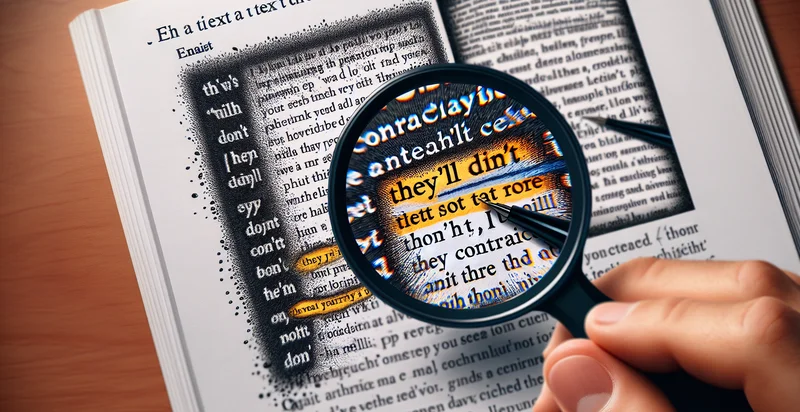Identify if a text contains a contraction
using AI
Below is a free classifier to identify if a text contains a contraction. Just input your text, and our AI will predict if it contains a contraction - in just seconds.

Contact us for API access
Or, use Nyckel to build highly-accurate custom classifiers in just minutes. No PhD required.
Get started
import nyckel
credentials = nyckel.Credentials("YOUR_CLIENT_ID", "YOUR_CLIENT_SECRET")
nyckel.invoke("if-a-text-contains-a-contraction", "your_text_here", credentials)
fetch('https://www.nyckel.com/v1/functions/if-a-text-contains-a-contraction/invoke', {
method: 'POST',
headers: {
'Authorization': 'Bearer ' + 'YOUR_BEARER_TOKEN',
'Content-Type': 'application/json',
},
body: JSON.stringify(
{"data": "your_text_here"}
)
})
.then(response => response.json())
.then(data => console.log(data));
curl -X POST \
-H "Content-Type: application/json" \
-H "Authorization: Bearer YOUR_BEARER_TOKEN" \
-d '{"data": "your_text_here"}' \
https://www.nyckel.com/v1/functions/if-a-text-contains-a-contraction/invoke
How this classifier works
To start, input the text that you'd like analyzed. Our AI tool will then predict if it contains a contraction.
This pretrained text model uses a Nyckel-created dataset and has 2 labels, including Contains Contraction and Does Not Contain Contraction.
We'll also show a confidence score (the higher the number, the more confident the AI model is around if it contains a contraction).
Whether you're just curious or building if a text contains a contraction detection into your application, we hope our classifier proves helpful.
Related Classifiers
Need to identify if a text contains a contraction at scale?
Get API or Zapier access to this classifier for free. It's perfect for:
- Customer Support Ticket Analysis: This use case involves analyzing customer support tickets to identify the tone and formality of the language used. By detecting contractions, the system can ascertain whether the customer's language is more casual or formal, helping support agents tailor their responses accordingly.
- Sentiment Analysis for Social Media Monitoring: Businesses can employ this function to analyze posts and comments on social media platforms. The presence of contractions might indicate a relaxed tone, which can be useful for sentiment analysis, helping brands understand public perception and engagement levels.
- Content Personalization for Marketing Campaigns: Marketers can use text classification to refine their messaging strategies. By identifying the use of contractions in previous successful campaigns, they can adjust new content to better resonate with their target audience's conversational style.
- Educational Tools for Language Learning: Language learning applications can utilize this function to highlight contractions in written exercises. This can help learners improve their understanding of informal language usage in English, enhancing their conversational skills.
- Chatbot Training Data Enhancement: Organizations can leverage the contraction identification feature to improve chatbot responses. By ensuring that the chatbot uses or recognizes contractions appropriately, the overall user experience can become more conversational and engaging.
- Text Readability Assessment: Publishers and editors can use contraction identification as part of a broader tool for assessing the readability of their texts. Knowing how contractions affect text can help them determine whether the content is appropriate for their intended audience's comprehension level.
- Legal Document Simplification: Legal firms can analyze contracts and agreements for the presence of contractions to ensure clarity and accessibility. Identifying overly complex language and replacing it with simpler forms can help make legal documents more understandable for clients.


